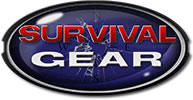Survival Water Purification
In order to have safe drinking water, you need to purify it before you drink it. Survival water purifiers come in different forms: tablets, powder, and filters. Choose your method and stock up for contingencies.
Water Purification for Survival
One of the main challenges in wilderness survival is not only finding water to drink but having the means to purify it. When creating or adding to your own emergency kit, use the easy button by adding methods like portable filters, purification tablets, or UV purifiers. These tools can transform questionable water sources into safe, drinkable water in just minutes, ensuring your health and hydration even in the toughest situations.
Whether you’re preparing for a hiking trip, camping adventure, or unexpected emergency, having a reliable way to purify water is a non-negotiable. Browse our water purification products and find the perfect solution for your needs. Don't leave survival to chance—equip yourself today and ensure your ability to stay safe, hydrated, and ready for whatever comes your way.
There are many ways to purify questionable water. While there are a ton of different filtering products available, let’s concentrate on the DIY approach.
Before proceeding with any purification process, you should first filter out the large “stuff” in the water. Coffee filters work well, as do a few layers of cloth such as old (but clean) T-shirts. The idea is to remove as many of the impurities as possible before purifying. This will serve to make the purification process cleaner, easier, and quicker. If you have the time, you can just let the questionable water sit in the container for a while and let the dirt and such settle to the bottom, then slowly and carefully pour the water off.
Once you have your filtered water, you can move on to purifying it for consumption.
Boiling: A tried and true method, though it can be time-intensive. The water should be at a rolling boil for at least five minutes before you can consider it safe to drink. Of course, there’s the time and energy expended to bring it to a boil, then the time for it to cool enough to drink. Covering the pot can reduce the time it takes to come to a boil. Also, the water might taste a bit flat. This can be helped by pouring it back and forth between two clean containers. Boiling is the best way to kill any parasites, short of using a very high-quality water filter. Helpful hint–the steam vapor rising up from your boiling water is also potable. Use a lid to trap it as it condenses so you don’t lose it.
Disinfecting: Add eight drops of unscented bleach to a gallon of water (two drops per quart) and mix well. Let it sit for about 30 minutes. The water should have a slight bleach smell. If it doesn’t, add the bleach again and repeat the process. To save you the math, this works out to 1/2 teaspoon of bleach for five gallons of water. If the water is cloudy when you start, double the bleach to be added. A suggestion would be to keep a bottle or two of bleach with your emergency supplies, with both an eyedropper and instructions taped to the bottle. Keep the bottle sealed as once it is opened, bleach will break down within just a few months.
Distillation: Even more time-intensive but little to no energy expended once you have the original set up completed. Dig a hole, around three feet across and three feet deep. Place a clean container in the center of the hole, then put a container of the questionable water near it. Cover the hole with clear plastic, like the kind you might use to cover a floor when painting (i.e. not thin plastic wrap from the kitchen). Secure the plastic with rocks or other weights. Then, place a small rock in the center of the plastic right above your clean container. You want the plastic to dip down slightly over that container. What will happen is the water from the full container will evaporate and condense on the plastic, then drip down to the clean container. Works best in warm, sunny weather. Obviously, this is more of a long-term solution rather than to satisfy a more immediate need.
